Metroid!
I’ve written about Metroid‘s opening moments before. As a matter of fact, I wrote about them nearly seven years ago, making this the game that set me on the path of thinking about how level design works. (That article isn’t dated here, but the crossposted version on 1UP.com says “June 24, 2006” — apparently I’ve been banging the same drum for quite a while.) So now you know where the blame lies. Really, though, I’ve only fully analyzed the first few screens of the game without giving too much consideration to what lies beyond. After this first entry, I’m curious to see what I’ll have to say about Metroid.
I suspect a lot of it will be negative, because this is one of those early attempts to do something bold and brash and deep, and as such it was staking out territory no other game had properly charted. Sometimes, such endeavors involve missteps.
And fair enough. Great design is timeless, while innovative design belongs very much to its times. To properly understand Metroid, you need to cast your brain into the proper mindset. The year is 1986, and nearly every action game on the market is either a reaction to Super Mario Bros. or else was undertaken a little too late to be able to reflect the development community’s collective desire to make the next Mario by… trying to create a game exactly like Mario. In short, the market is suddenly glutted with games that try to imitate Mario‘s physics and rules, or else feel heartbreakingly primitive in their lack of comparative sophistication.
Metroid‘s designers, on the other hand, said, “Hey, let’s totally blow Mario out of the water.” They made a game that completely abandoned fundamental action game concepts like levels, scores, and ease of accessibility. It was a game with the sort of expansiveness you’d only have seen on a personal computer, except it ran on a console. That meant you didn’t have to control the action with arrow keys, it had good music, and it didn’t use black-and-white isometric graphics. It was like nothing else on consoles, which made it seem pretty awesome in its day. After all, its flaws didn’t seem quite so glaring when we didn’t have better efforts to compare it to.
Metroid kicks off with a degree of ceremony reminiscent of Namco’s classic arcade titles — like Xevious, Pac-Man, and Tower of Druaga, you hear a brief musical flourish before you begin play. The hero(ine) Samus materializes with a unique sprite (you only see it here and while riding the elevators between areas), then the action begins.
In 1986, side-scrolling games almost universally worked in one direction: Left to right. Look at Moon Patrol, Pac-Land, Super Mario Bros., Wonder Boy. Shooters like Gradius and Scramble cemented the auto-scrolling left-to-right horizontal format for that genre (Defender being little more than a strange blip in history). Even Rolling Thunder, which allowed some small amount of backtracking, offered the player no reason to walk left besides dropping back for tactical purposes. So why would Metroid be any different?
From the outset, Samus dashes right, gunning down what monsters she can draw a bead on — basically the pteranodon-like creatures that lurk on the ceiling and dive downward when Samus comes into range, launching a literal suicide attack by trying to skewer the heroine before lodging in the ground and exploding. These deathwish beasts serve their purpose, though: They teach players to aim and shoot upward and the value of rapid fire as advancing enemies will be halted for a frame or two of action when struck, allowing a rapid volley of shots to take down a speedy foe before it can collide with Samus.
Her line of fire unfortunately does not include Zoomers, the short spiky critters walking along the ground, as they move below the range of Samus’ blaster; sadly, she’s unable to duck and fire or aim downward. However, she can hit them when they climb on walls and ceilings: An observation you’re left to make at the end of the first room. Metroid operates on its own unique combat logic (well, “logic”), but it does a good job of allowing you to explore some of Samus’ basic skills right away.
Samus begins the game with 30 points of health, and enemies in this region (Brinstar) will sap eight points per attack. This allows players to make three mistakes before dying, and most defeated enemies drop health refills worth five points. So basically for every couple of creatures you destroy, you can absorb another hit. For now, Samus’ health maxes out at 99 health, so the game allows quite a bit of leeway for sloppy play — which is good, because she has very little mercy invulnerability and totally weird jump physics.
Metroid doesn’t have levels, but it does break its world into rooms — a little like its contemporary Castlevania, but with a major distinction. Rooms in Metroid alternate between vertical and horizontal scrolling. Unlike nearly every other game of its vintage, Metroid can scroll in four directions… but only two at a time, and the scroll orientation always alternates between rooms. I don’t think the change in directions is a specific limitation of the tech the team used for the game. Given that Metroid‘s sibling Kid Icarus (they share quite a bit of staff) does something similar it seems to be a conscious design style by the team rather than some kind of hardware requirement.
In your first time through the game’s second room, you can’t actually move vertically yet. So instead all the second room provides is a change in scenery; the level design goes from a fairly flat, open space to a series of odd-looking blocks arranged in horizontal layers, with one row situated above the floor. This forces players to scramble across the top while Zoomers crawl toward her. The raised platform and low ceiling mean you can’t simply jump over these creatures, forcing you to either time your dash across the platform to when they’re moving across its underside or else fire at them as they round the corner and come briefly into Samus’ line of fire. Either way, this room places monsters directly in your path and forces you to come to terms with them. And it holds secrets that you’ll later come to realize.
The next room is structured more like the first, with two of the dive-bombing Skree situated near the entrance. If you simply dash forward, the arc of your fall from the platform beneath the door will cause you to fall directly into their diving path, and the Zoomers moving along the ground will further complicate things. Instead, the correct approach is to slow down and drop gently from the ledge once the Zoomers pass beneath you, allowing you to lead the Skree one at a time and take out the Zoomers as they climb above you. For those used to the mad dash of a Super Mario Bros. or Wonder Boy, Metroid demands an uncommon degree of patience.
With the enemies taken care of, Samus comes to this low-hanging wall. With only a single-block gap between the overhang and the floor, Samus is physically incapable of advancing forward. She can’t duck or crawl, and she can’t pass through walls, so she’s effectively stuck.
For the first-time player in 1986, this created a confounding situation. You couldn’t advance; was there a secret? A trick? A mysterious way to get past this obstacle? You might begin to backtrack a little way to look for some kind of secret, something you’d missed. You’d push further and further back until…
…you were back here, at the beginning. But the screen kept scrolling, and no invisible wall prevented you from running left from the initial screen as it did in games like Super Mario Bros. and Pac-Land. You could run left for an entire screen or two, pushing back against what should have been an invisible boundary.
And eventually, you’d come to this: The Maru Mari, more commonly known as the Morph Ball. The Maru Mari allows Samus not only to duck, but to roll into a compact ball one meter high — just small enough to roll through one-block-high gaps.
In fact, once you’ve jumped over the large construct immediately to the left of the starting point, you’re forced to acquire the Mari Mari. The structure is too high to leap, and it’s too low to walk under. You can only return to the main game by ducking into a ball and rolling beneath the obstacle. Congratulations: You’ve just learned how to advance by using the Maru Mari.
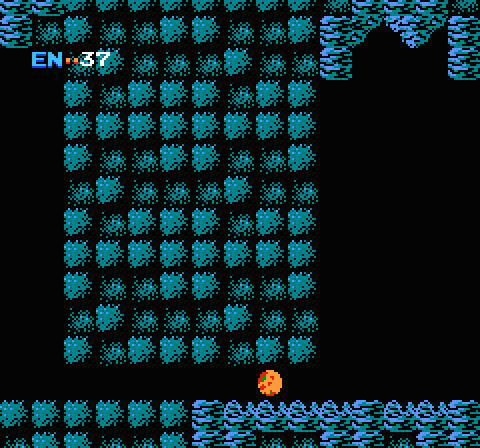
You can do the same thing at that ledge in the third room. Welcome to the rest of the game.
It’s impossible to overstate how brilliantly the Metroid team executed this whole thing. They could have gone about it any number of ways. They could have placed the Maru Mari along your path. They could have forced players to run left from the start. They could have introduced the low wall much further into the game.
By placing this obstacle in that exact location, however, Metroid‘s designers turned progress into a test, and in doing so drilled the importance of your actions into your own mind. Instead of parceling out instructions or simply creating a mandatory learning process along the main path, the game forced players (accustomed to one-directional ratchet scrolling) to deduce a lot of different things at once: The freedom to move in either direction, the need to backtrack and explore, the importance of collecting items. Along the way, players learned both to use the Maru Mari and how to deal with certain enemies, the process of moving from room to room, and the fact that the game ahead would be packed with mystery.
Something I find particularly interesting about this sequence is that the distance from the Maru Mari to the low wall is nearly the same amount of screen real estate as World 1-1 of Super Mario Bros. The path to the wall essentially comprises the same volume of content as a normal level of contemporary games. Yet because of the need to double back and deal with threats that need to be dealt with with specific strategies, this sequence feels considerably different than the brisk dash through an opening stage seen in Metroid‘s contemporaries.
Whatever failings it may possess, Metroid begins with an extraordinary playable opening sequence. It may be hard to fully appreciate today, but viewed in the context of its time and place, this opening salvo served as a rousing statement of intent.
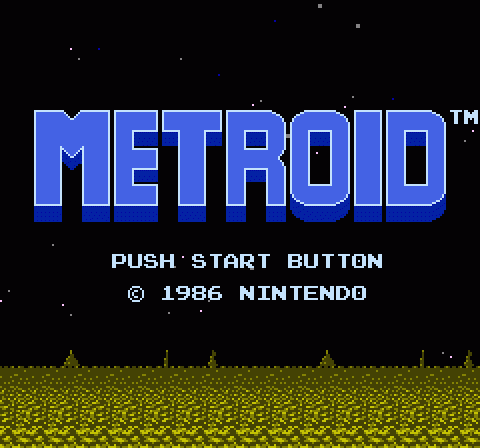
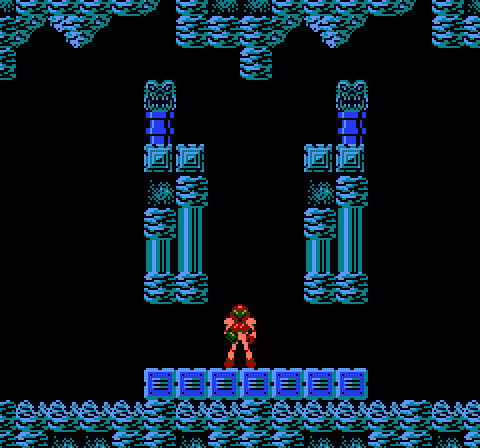
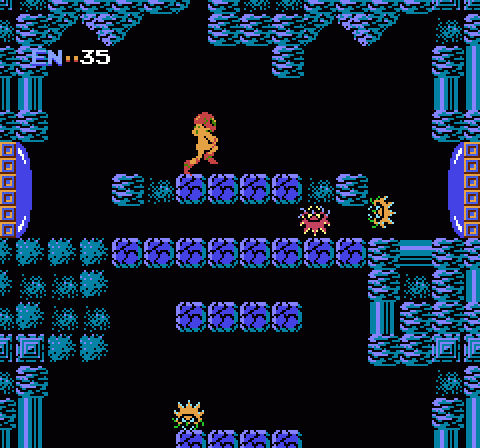
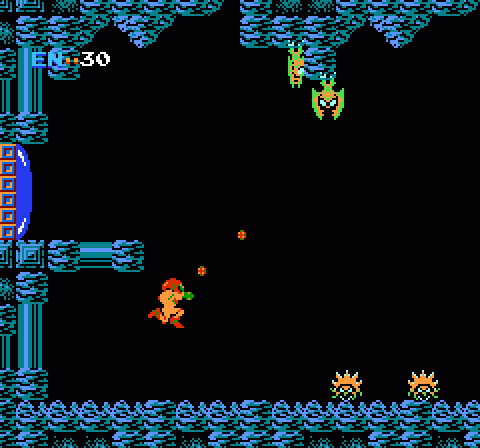
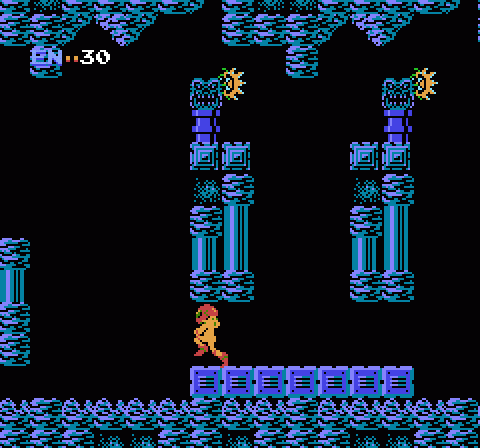
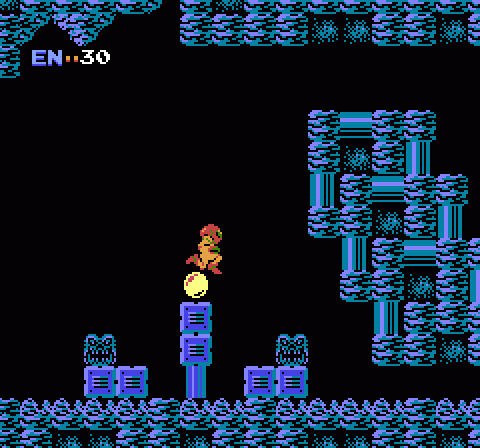
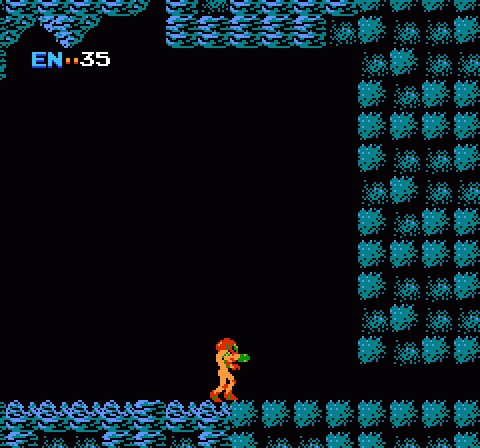
Great article! I agree with you the whole horizontal/vertical alternating scroll must be by design choice, but I don’t think it always alternates. Mother Brain’s room in Tourian, any room with a Chozo statue/powerup, Ridley’s room, and a few random 1 screen rooms in Norfair and Kraid’s Hideout seem to be joined with other horizontal rooms. It is possible though that in some of these cases, they exist as part of a larger vertical room that gets texture changes and doesn’t actually allow you to travel vertically (I’m not counting room that appear to be horizontal, but you can actually blast through the ceilings/floors). It’s hard to say because the maps are so dense and so many rooms touch each other and could technically be the same in the code despite looking different on screen - but there are at least a few that definitely don’t seem to alternate.
Out of curiosity, what is your process for writing these? Do you you write them as you play the game? Do you play a predetermined part of the game and them write about that part, having divided the game in section before hand? Do you play the whole game and then go back and break it into sections?
Play a bit, write about it, play the next bit, etc.
Kid Icarus and Metroid share an engine so no surprise that they both have the same limitation with respect to scrolling. In fact, it is a technical one. There was a post on the Romhacking.net forum a few years back that went into detail but long story short, the way memory is accessed to implement scrolling makes doing it in both directions very difficult.
For whatever reason, the first time I played Metroid, I went left. I might have had a Nintendo Power guide, or I might have just wanted to see if it’d work. But at any rate, I never quite appreciated how well this area was put together until your original article on it. Nice to see it revisited as you delve into the game.
The invincibility password (NARPAS SWORD0 000000 000000) is a great way to experience Metroid without the frustration of starting over at 30 health all the time. That’s what I’d recommend to anyone coming to the game for the first time today. Just don’t fall in the lava in the eyeball room of Norfair, because there’s no way out.
Metroid means more to me personally than Zelda 2 or other similar games of that era, but to be honest the flicker and slowdown are pretty bad. I like the color glitches and secret worlds, though. And the mid-air unmorph jump that was probably not put there by design.
You just made something profound dawn on me. All the years I’ve been playing games I’ve used guides (NP issues, full-fledged strategy guides, GameFAQs, etc.) as a crutch. The skills I practiced back then were memorizing facts and honing reflexes, not solving problems, because the guides solved the problems for me. Admittedly, most adventure games and RPGs came with instructions so big that they almost doubled as guides, but still, I’ve done very little over the years to figure out games on my own. In the 8-bit and 16-bit years I just figured that people who didn’t read guides were dumb, and people who could figure out games without them were smarter than I am.
How did you approach games like this back in the day? Did your friends back then use guides or not?
Always restarting at 30 health is the one reason I’ve never gone back to this game with any seriousness. I heard someone made a hack which starts you at full health each time you die or enter a password, though if Nintendo adds this to the Wii U Virtual Console, I might just use the Restore Point to get past that particular hump.
Reading about the layout here does shed light on how clever the designers were in educating players about the game’s mechanics through doing experimentation, rather than a wordy tutorial. But as Sarcasmator said, I remember going left at the outset- though in fairness, I didn’t really play the game much until after things like Zelda had come along, too, so maybe I saw “left” as more of a limitation specific to Super Mario Bros.
The Metroid romhack that refills all your energy tanks back to maximum upon restart is called ‘Metroid 99’:
http://www.romhacking.net/hacks/504/
I’d encourage anyone curious about playing through Metroid to use it.
Revisitng Mertoid in general:
Metroid has a reputation of being unapproachable to anyone trying to beat it/get far for the first time today. Don’t let this scare you off. The hack does a lot right for making the game fun. The other roadblock will be getting stuck on exploration. Online maps and walkthroughs are your safety net here.
Without these roadblocks, the game is tough but fair. You’ll be in for a rewarding experience and a nice dose of Metroid history.
Just a quick technical note I learned from my experiments romhacking this game: the alternating-direction scrolling is not, in fact, hard-coded into the game! It was very much a design choice.
The way the scrolling changes work is, as one might expect, tied to the doors. But there are actually *two* door objects, visually and behaviorally identical! One of them (by far the more commonly used one) switches the scrolling from horizontal to vertical, and vice-versa. The other leaves it the same. Most of them are used directly in front of rooms with Chozo Statues, to keep the scrolling horizontal, but I believe they are also used around Ridley’s room, so there is still lava there.
Oh, right, that reminds me. Lava? Hard-coded into *every* horizontal-scrolling room. The ‘lava’ tile is just graphics; the only thing keeping you from getting hurt most places is the presence of solid flooring. Metroid used all kinds of neat little programming tricks to save space, all so that they had room to store that one enormous map. It’s kind of a marvel of ancient software engineering, well worth checking out if you’re into that kind of thing.
Crap! I should mention that I used the famous Met-Edit program to do my romhacking experiments, and everything I just said I deduced from qualities I found by fiddling around with that. I’m not claiming to be the first person to discover this stuff, sorry if I accidentally made it sound that way. D:
@The Undesigner: I’m curious, though, if the forced scrolling (either horizontal or vertical) wasn’t so much a hardware limitation in the US version, which was on cart and used the MMC1 mapper, and more the vestiges of its original launch platform, the Famicom Disk System. Are there any mixed-scrolling games for the FDS? I must admit I’m not well-versed on the hardware capabilities of the FDS.
Zelda II is an FDS game, and it has free scrolling. It’s not a hardware limitation but a matter of the game code.
Ah, yeah, that’s right. I don’t know why I forgot Zelda II was FDS as well.
So, do any games support diagonal scrolling without a chip?
Actually, forget I said anything. I know it was tricky to do so without a MMC3 or whatnot, but games like R.C. Pro-Am did a lot of diagonal scrolling, although I’m not sure if that was a chip thing or the devs just performing some trickery.
Was on BART the other day and got a 3DS tag …
http://i42.tinypic.com/qntwfc.jpg
But I don’t ride BART! Please keep this evil doppelganger far away from me.
@Sarge: Sorry if I was unclear; I was talking about the fact that rooms generally switch *between* vertical and horizontal scrolling when you go through a door, not the fact that scrolling is always mono-directional. The fact that it’s mono-directional is certainly hard-coded into the game, and I suspect that with the size of the map already straining the limits of the cartridge’s memory it would have been pretty hard for them to do it any other way. I’m not an expert on NES hardware or assembly code, though - far from it. I merely dabbled for a short while.
@The Undesigner: Ah, okay, cool. I’d always wondered about that. I’m certainly no expert myself. I’ve read some of the technical documents on the NES, and am fascinated by stuff like that (I am a computer engineer by trade), but I’m not overly familiar with the architecture, and haven’t dived into the world of ROM hacking. I want to, though! Maybe I’ll find some time eventually. It’s awesome that you’ve dug into it at least to some degree!